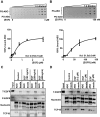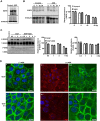Cellular uptake mediated by epidermal growth factor receptor facilitates the intracellular activity of phosphorothioate-modified antisense oligonucleotides
- PMID: 29514240
- PMCID: PMC5909429
- DOI: 10.1093/nar/gky145
Cellular uptake mediated by epidermal growth factor receptor facilitates the intracellular activity of phosphorothioate-modified antisense oligonucleotides
Abstract
Chemically modified antisense oligonucleotides (ASOs) with phosphorothioate (PS) linkages have been extensively studied as research and therapeutic agents. PS-ASOs can enter the cell and trigger cleavage of complementary RNA by RNase H1 even in the absence of transfection reagent. A number of cell surface proteins have been identified that bind PS-ASOs and mediate their cellular uptake; however, the mechanisms that lead to productive internalization of PS-ASOs are not well understood. Here, we characterized the interaction between PS-ASOs and epidermal growth factor receptor (EGFR). We found that PS-ASOs trafficked together with EGF and EGFR into clathrin-coated pit structures. Their co-localization was also observed at early endosomes and inside enlarged late endosomes. Reduction of EGFR decreased PS-ASO activity without affecting EGF-mediated signaling pathways and overexpression of EGFR increased PS-ASO activity in cells. Furthermore, reduction of EGFR delays PS-ASO trafficking from early to late endosomes. Thus, EGFR binds to PS-ASOs at the cell surface and mediates essential steps for active (productive) cellular uptake of PS-ASOs through its cargo-dependent trafficking processes which migrate PS-ASOs from early to late endosomes. This EGFR-mediated process can also serve as an additional model to better understand the mechanism of intracellular uptake and endosomal release of PS-ASOs.
Figures









Similar articles
-
Golgi-58K can re-localize to late endosomes upon cellular uptake of PS-ASOs and facilitates endosomal release of ASOs.Nucleic Acids Res. 2021 Aug 20;49(14):8277-8293. doi: 10.1093/nar/gkab599. Nucleic Acids Res. 2021. PMID: 34244781 Free PMC article.
-
Intra-endosomal trafficking mediated by lysobisphosphatidic acid contributes to intracellular release of phosphorothioate-modified antisense oligonucleotides.Nucleic Acids Res. 2017 May 19;45(9):5309-5322. doi: 10.1093/nar/gkx231. Nucleic Acids Res. 2017. PMID: 28379543 Free PMC article.
-
Lipid Conjugates Enhance Endosomal Release of Antisense Oligonucleotides Into Cells.Nucleic Acid Ther. 2019 Oct;29(5):245-255. doi: 10.1089/nat.2019.0794. Epub 2019 Jun 3. Nucleic Acid Ther. 2019. PMID: 31158063
-
Cellular uptake and trafficking of antisense oligonucleotides.Nat Biotechnol. 2017 Mar;35(3):230-237. doi: 10.1038/nbt.3779. Epub 2017 Feb 27. Nat Biotechnol. 2017. PMID: 28244996 Review.
-
EGFR Trafficking in Physiology and Cancer.Prog Mol Subcell Biol. 2018;57:235-272. doi: 10.1007/978-3-319-96704-2_9. Prog Mol Subcell Biol. 2018. PMID: 30097778 Review.
Cited by
-
Membrane Destabilization Induced by Lipid Species Increases Activity of Phosphorothioate-Antisense Oligonucleotides.Mol Ther Nucleic Acids. 2018 Dec 7;13:686-698. doi: 10.1016/j.omtn.2018.10.011. Epub 2018 Oct 24. Mol Ther Nucleic Acids. 2018. PMID: 30508785 Free PMC article.
-
mRNA levels can be reduced by antisense oligonucleotides via no-go decay pathway.Nucleic Acids Res. 2019 Jul 26;47(13):6900-6916. doi: 10.1093/nar/gkz500. Nucleic Acids Res. 2019. PMID: 31165876 Free PMC article.
-
Selective tissue targeting of synthetic nucleic acid drugs.J Clin Invest. 2019 Mar 1;129(3):915-925. doi: 10.1172/JCI125228. Epub 2019 Jan 28. J Clin Invest. 2019. PMID: 30688661 Free PMC article. Review.
-
Current Development of siRNA Bioconjugates: From Research to the Clinic.Front Pharmacol. 2019 Apr 26;10:444. doi: 10.3389/fphar.2019.00444. eCollection 2019. Front Pharmacol. 2019. PMID: 31105570 Free PMC article. Review.
-
Oligonucleotide Phosphorothioates Enter Cells by Thiol-Mediated Uptake.Angew Chem Int Ed Engl. 2021 Aug 23;60(35):19102-19106. doi: 10.1002/anie.202107327. Epub 2021 Jul 21. Angew Chem Int Ed Engl. 2021. PMID: 34173696 Free PMC article.
References
-
- Wu H., Lima W.F., Crooke S.T.. Properties of cloned and expressed human RNase H1. J. Biol. Chem. 1999; 274:28270–28278. - PubMed
-
- Bennett C.F., Swayze E.E.. RNA targeting therapeutics: molecular mechanisms of antisense oligonucleotides as a therapeutic platform. Annu. Rev. Pharmacol. Toxicol. 2010; 50:259–293. - PubMed
-
- Crooke S.T. Antisense strategies. Curr. Mol. Med. 2004; 4:465–487. - PubMed
-
- Yu R.Z., Grundy J.S., Geary R.S.. Clinical pharmacokinetics of second generation antisense oligonucleotides. Expert Opin. Drug Metab. Toxicol. 2013; 9:169–182. - PubMed
-
- Crooke S.T. Progress in antisense technology. Annu. Rev. Med. 2004; 55:61–95. - PubMed
Publication types
MeSH terms
Substances
LinkOut - more resources
Full Text Sources
Other Literature Sources
Research Materials
Miscellaneous

